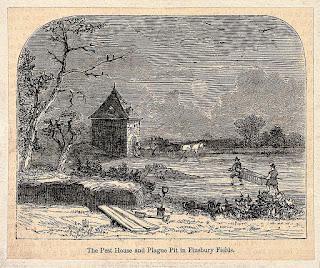Taphophobia, or the fear of being buried alive, has a long history. Tales of people being buried prematurely have been related for centuries, and at least some are well documented. The fear of such a fate seems to have increased, in Europe and America at least, from the late 18th century.
Louisa Wells Aikman, in a narrative she wrote in 1779, mentions the case of George Woodrop of Charleston, South Carolina, a young man in his early twenties who had died in 1770. The burial had been unusually quick. Woodrop was pronounced dead in the evening and was buried the next morning at 11:00. His uncle, Andrew Robertson, insisted on dispensing with the traditional practice of "laying out" the body in the house for a time before interment.
Louisa's father Robert Wells had been a mourner at the funeral. He had "expressed great uneasiness, and said that the body did not appear like a dead corpse, there seemed to be a bloom on the countenance!" Wells asked the reason for the hurry in burying Woodrop. Mr. Robertson replied, "Mrs. Robertson could not bear to have the deceased in the house as she had so many young children."
About two years later, rumors spread around Charleston that Woodrop had been buried alive. During her voyage to London in 1778, the church sexton John Mills, told Louisa and other passengers that the rumors were true. Mills said that he had kept silent on the matter until that time because he had promised the Robertsons that he would not speak to anyone about the subject. But the Robertsons were now dead and he felt released form that promise.
One night Mills was preparing a grave to bury someone the next morning, assisted by "two black boys." While they were digging, the shovel hit and broke off part of a coffin. Mills went down into the grave and discovered "the backbone of a human skeleton."
The posture of the body seemed unusual. Aided by the boys, Mills "opened the grave, uncovered the lid of the coffin, and found the deceased lying on its side, with the cheekbone in the palm of the hand!" The coffin cover bore the words "George Woodrop died 1770." We may not be convinced by this evidence, but Louisa Aikman certainly was, and perhaps others as well.
One of them may have been another Charleston resident, Henry Laurens. He stipulated in his will that his head should be severed and his body burned after death. Laurens believed that his infant daughter Martha had narrowly escaped being buried alive. It is possible that he was aware of the Woodrop case as well because he knew the Wells family. In 1792 Laurens' body was burned on a pyre at his plantation, Mepkin. It was the first documented case of cremation in the United States.
In an appendix to her narrative, Louisa Aiken wrote that the Woodrop case had affected her mind so much that she "never forsook the apparently dead or dying until interment." During the twenty years she lived in Jamaica (1782-1801) she reckoned that her watchfulness had prevented eighteen people from being "sent to an untimely grave."
She mentioned in particular the case of fourteen year old James Haughton, from 1785. He seems to have been suffering from yellow fever -- Louisa mentions "a constant bleeding at the nose." For several hours "Animation was suspended." Doctors declared him dead. His mother agreed and with a lack of emotion went off to dress for his funeral.
Louisa persevered in trying to save him. With the help of "slaves" she applied the method recommended by the Humane Society, and he revived. When his "unnatural parent" returned, "curled and powdered" and dressed in a black silk dress, her son was sitting up "eating sago from my hands." Fifteen years later he was still alive, had married twice and had several children. [Image: Louisa Wells Aikman]
Concerns about premature burial seem to have increased during the Victorian Age. The suffragette and anti-vivisectionist Frances Power Cobbe is one of many people who feared being buried alive. It had nearly happened to her great grandmother, according to family tradition. Her ancestor was believed dead and being prepared for burial when she woke up. She went on to have twenty-two children. (Maybe it would have been better to be buried alive).
Cobbe was particularly worried about the effects of a stroke or seizure which might render her unconscious for enough time for people to think she was dead and bury her. She left behind explicit instructions about the measures she wanted performed to prevent such an outcome. In a note next to her bed she ordered a doctor to sever the arteries and windpipe on her neck, virtually cutting off her head, "to render any revival in the grave absolutely impossible."
Interestingly, she also ordered that her burial be as natural and inexpensive as possible. She stipulated that her coffin be made of wicker that would decompose quickly, that the coffin would not be carried by six men but taken in her carriage by her coachman, who would deposit it in the grave. She also forbade attendees to wear mourning attire.
The increase in fear of premature burial during the Victorian era was due in part to the massive growth of the urban population. The crowded and unsanitary conditions rapid urbanization created fostered epidemics of cholera, typhoid and other diseases.
The frequent epidemics helped to change the conditions but also customary burial practices. The tradition in many countries was to lay the body out for several days before burial, at which point it would normally exhibit clear visual and olfactory signs of mortality.
During deadly epidemics, burials often took place as quickly as possible in hopes of preventing the spread of disease. Rapid burials increased fears that some people were being entombed before death.
Art and literature also contributed to the growing sense of alarm. During a cholera epidemic in 1854, Belgian artist Antoine Wiertz painted "The Premature Burial." The painting depicts a cholera victim awakening after being placed in a coffin.
Writers also addressed the subject, notably Edgar Allen Poe in his story of the same name. In the 19th century estimates of the number of people buried prematurely varied from occasional cases to a preposterous one-third of those buried.
Whatever the reality regarding premature burials, fear of it was common enough to inspire Victorian entrepreneurs to devise means of prevention. They designed "safety" coffins with various escape mechanisms or means by which prematurely buried persons could signal that they were alive.
An early safety coffin, patented in the USA in 1843, contained springs and levers that would open the lid with slightest movement inside, or so the inventor claimed.
Many safety coffins featured a bell on the lid from which a rope was attached. The rope was inserted into a hole in the lid and placed in the hands of the coffin's occupant. If they revived they could pull the rope to announce the fact. The one below, patented in the 1860s, added an escape hatch and a ladder as well. Michael Crichton, in his novel The Great Train Robbery, includes a scene in which one of the robbers is placed in such a coffin to fool railway guards.
Alas, despite the claims of inventors, there is no documented evidence that any of these safety features saved anyone from premature burial.
,
























.jpg)




